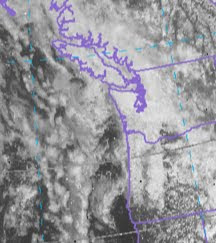NOTE: Will be trying the videopodcast tomorrow (Friday) morning again. Hopefully will be a bit smoother!...cliffToday the NWS released a statement confirming that an EF0 tornado (the weakest kind) hit about a mile east of Napavine, a small town in SW WA near I5 around 2 PM (2100 UTC) on Friday (see map):The tornado touched the ground for a few hundred...
Thunderstorms on the Eastern Slopes of the Cascades
| comments

With southeasterly flow aloft and modestly unstable air over eastern Washington, thunderstorms are breaking out on the eastern slopes of the Cascades right now (2 PM on Monday). This convection occurs as the lifting caused by the eastern Cascade slopes releases the convection. On days like today, the atmosphere is in a state where thunderstorms...
Sunday and Monday
| comments

Yesterday brought quite a bit of sun to the lowlands, clouds and some some showers to the mountains, and if the day was not great it was generally acceptable for most.Last night the low clouds thickened for much for much of region...here is the visible satellite photo around 8 AM Sunday:Lots of low clouds offshore, over SW Washington, and over the...
Update and Test: Plus the Memorial Day Forecast
| comments

I am testing a new approach to providing my weather discussion---a video podcast using YouTube. Here is a rough first attempt:http://www.youtube.com/watch?v=jxbwLeZUIMsDo you think this is worth perfecting? Like it?Major news today! The antenna and radome were placed on top of the tower for the new Langley Hill Weather Radar. Here is the picture:Folks..this...
The Memorial Weekend Forecast
| comments

Since I can't provide the weekend forecast on KUOW today, I thought I would do it here on the blog.The bottom line. We are in a cool, cloudy pattern, but with no big storms. Relatively cool and lots of clouds, with the best weather expected on Sunday.OK, lets get into the details. Today we have cool, unstable air over us with lots of showers....
Tornado Passage at a Weather Station
| comments

There has been a lot of coverage of the recent tornadoes, but here is something not covered by the press. Yesterday a tornado passed extremely near or over the Oklahoma Mesonet weather station at El Reno (several people died unfortunately in this event). Here is the observation--amazingly the instrumentation survived! (click for bigger image)The tornado...
Why Does the U.S. Midwest Get So Many Severe Thunderstorms?
| comments

Last night another tragic bout of severe weather struck the U.S., Midwest, with a strong tornado leveling a large section of Joplin, Missouri (see video below). It may well happen again today. Looking at the climatology of U.S. tornadoes (below), you see that although the High Plains are struck most frequently, the southeast, and the upper Midwest...
June Gloom and KUOW Weekday
| comments

Lets talk about weather first....During late May and much of June low clouds tend to dominate the western lowands of Washington and the nearby offshore waters. Know as "June Gloom" in many circles, such persistent low cloudiness is a very typical feature of our climate. June is simply not a great month here and there are reasons for that.Case in...
No More Weather on KUOW Weekday
| comments
For over 15 years, I have talked about Northwest weather, the weekend forecast, and education-related topics on KUOW during Friday's morning's Weekday program.I have done so as my attempt at educational outreach, to go beyond the basic forecasts given on other media, providing the why behind the weather and to allow local residents a chance to appreciate the grand complexity of the weather of this beautiful area of the world. And occasionally to talk about related educational issues.Starting tomorrow, I will not have the opportunity to do so anymore on KUOW. On Monday I received an email from Weekday host Steve...
70F on Friday?
| comments

Time to get out the shorts, sunglasses, and beach gear.After one of the coldest springs on record it appears that temperatures will climb into the 70s on Friday and perhaps for a few lucky folks tomorrow.The air is progressively warming and today temperatures hit the mid 60s in much of the lowlands. Warm enough to get our old friend, the Sound Breeze,...
Seattle Schools Lawsuit, Enfield, and Common Core
| comments

I would like to update you on the math lawsuit against Seattle Public Schools, reveal an interesting encounter with Seattle Superintendent Susan Enfield, and tell you the depressing tale of our state's math curriculum.As many of you know, I was involved in a lawsuit against Seattle Public Schools with two other local residents, Martha McLaren and DaZanne...
An Unusual Spring Rain
| comments

Our rain has even made CNN:SUNDAY NIGHT UPDATE: Sea Tac broke its daily records for both Saturday and Sunday. A number of stations in the south Sound received 1.5-2 inches of rain today.For days the numerical models indicated substantial rain over the weekend, and yesterday's runs really took me back. Here is the forecast 48-h rainfall totals ending...








